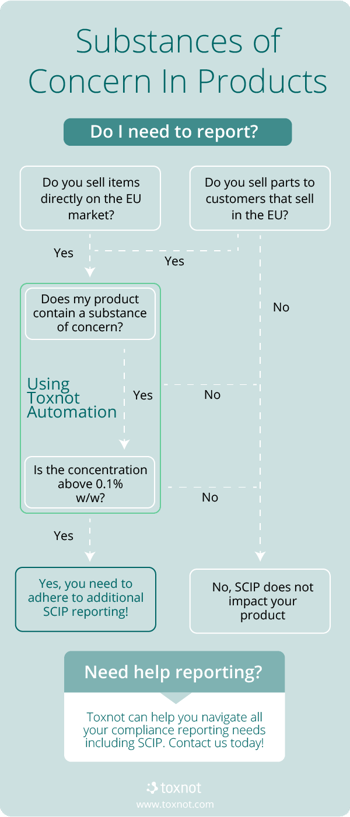What is SCIP?
SCIP is a database for information on Substances of Concern In Products (SCIP) and is part of the Waste Framework Directive (WFD). WFD, like REACH, is an European Union (EU) piece of legislation that creates a structure in which manufactured products are managed and reported. REACH aims to improve protection and reduce risk of human and environmental exposure posed by chemicals. WFD on the other hand addresses the adverse impact of waste generation and improving efficient use of resources to promote the transition to a circular economy. The SCIP database, as part of this effort, has three main objectives:
- Decrease the generation of waste containing substances of concern under REACH
- Make information available to those upstream in the supply chain and for consumers to improve waste handling operations
- Allow authorities to monitor and provide insight into product lifecycles, and ultimately initiate appropriate actions for pursuing the goal towards a circular economy
REACH, WFD, and subsequently SCIP are all managed and enforced by the European Chemicals Agency (ECHA).
Am I affected by SCIP?
All parts, materials, articles, and objects placed on the EU market containing a substance of very high concern on the REACH Candidate List in a concentration above 0.1% w/w are required to submit SCIP notification. Suppliers of these items that need to provide information to ECHA include producers and assemblers, importers, and distributors that reside in the EU. As established under REACH, companies that reside outside of the EU and wish to place their product on the EU market, must either establish a legal entity within the EU in which to operate or utilize an EU importer.
As such, any manufacturer that places product on the EU market are affected. Not all manufacturers would necessarily file directly such as if using an importer, but would need to provide the necessary SCIP data to those that need to submit reports, which is beyond the data needed for EU REACH compliance. Furthermore, manufacturers further up the supply chain could potentially be impacted even if they do not directly sell in the EU by receiving requests for product information. Toxnot can help simplify this complexity, collected the needed data from your suppliers, determine if you are affected by this new requirement, and generate the necessary reporting if required.
For example, say an American furniture manufacturer sells kitchen cabinets into the EU via an importer. The furniture maker has multiple suppliers of materials to build its products including a locally-based supplier of cabinet handles and knobs. These handles are known to contain a substance of high concern. Working backwards, the importer is responsible for filing to SCIP and providing information to ECHA. In order to continue importing the furniture maker’s cabinets, it must have all the necessary information from the manufacturer. Subsequently, the manufacturer must now survey the handle and knob supplier to get data necessary for the SCIP submission to pass on to the importer. In this example, the handle and knob supplier may only sell domestically, but will need to begin providing new reporting data to its customer and will have to meet new requirements for SCIP.
When do I need to comply?
ECHA is allowing data submissions to begin in October 2020. Information on all articles that meet the criteria need to be submitted by the January 5th, 2021 deadline and maintained in perpetuity. This means a three-month window is available for initial submissions. It is strongly encouraged to plan your SCIP compliance well in advance. All data is expected to be collected from upstream suppliers and submitted by the January 5th deadline, so getting started early is essential. Complex products many require surveying of suppliers, and those suppliers in turn may need to conduct their own surveys further up the supply chain to gather all necessary data. These endeavors can take time.
How do I get started?
First, you need to understand your product library and identify which parts contain substances of high concern on the candidate list above a concentration of 0.1% w/w. This also includes all the parts of complex products, such as the knob in the previous example. This can be burdensome, but Toxnot automates this to identify what sourced and manufactured materials meet the requirement thresholds. For identified items, further information needs to be either provided or gathered from suppliers to complete required reporting. Toxnot has supplier engagement functionality to automate and manage outreach to supply chains to obtain SCIP reporting data with dedicated survey templates so the correct information is requested.
What data is required for SCIP reporting?
SCIP reporting includes both mandatory and optional datapoints but can be generalized into these categories below. Keep in mind this data needs to be collected for each complex product as a whole as well as for each and every individual part within that product that meets the criteria for inclusion (contains a substance of concern over the specified threshold).
Item Data:
- Identifiers – This includes all information that can be used to identify a product including name, brand, category, or other unique identifiers such as a product code, part number, or similar.
- Imagery – Pictures of the product
- Characteristics – Distinguishing features of the item such as dimensions, weight, and color
- Safe Use Instructions – Information on properly handling the product that contains a substance of high concern. Can also contain disassembling instructions, such as a PDF.
Substance Data:
- Substance – Specific substance of concern found in the item that is of high concern identified by name, EC and CAS number
- Concentration – How abundant is the substance in the item
- Category – Information about the material where the substance is found in the item
Toxnot has pre-built supplier survey templates that ask all the right information for you to submit your SCIP data with confidence.

How do I submit?
Identifying the appropriate filer for your products is the first step. Next would be providing them with the appropriate information so they can submit to ECHA and the SCIP database. If submitting directly to ECHA, you can use the Toxnot automatic filer function. If submitting to another entity to file, you can use our export feature to generate reports.

Interested in discovering even more insight on product compliance?
Our compliance trends download shares how to help you drive major changes in your approach to product compliance.

